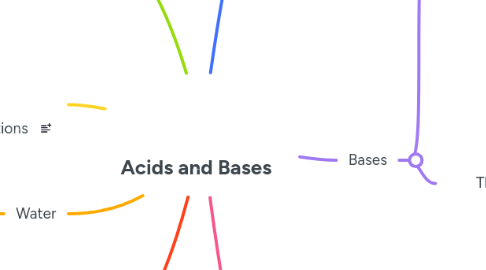
1. The pH scale
1.1. Runs from 0-14
1.1.1. 0-6.9 are acids
1.1.1.1. Red, orange and yellow in universal indicator
1.1.2. 7.0 is neutral
1.1.2.1. Bright green in universal indicator
1.1.3. 7.1-14 is alkaline
1.1.3.1. Blue and purple in universal indicator
1.2. The substance must be added to water before the pH can be tested
1.3. Used to measure the acidity of a substance
2. Precipitation reactions
2.1. Two solutions are mixed together to form another solution and a solid
2.1.1. The solid is the precipitate
2.1.1.1. The ions which have not reacted are known as spectator ions
2.1.2. The precipitate can be identified using the table of solubilities in the data booklet
3. Water
3.1. Water contains very small but equal quantities of hydrogen and hydroxide ions
3.1.1. If there is an excess of hydroxide ions, an alkali is formed
3.1.2. If there is an excess of hydrogen ions, an acid is formed
4. Salts
4.1. Salts are always formed in neutralisation reactions. They are named by taking the metal part of the base and joining it with the following ending from the acid that was used.
4.1.1. Hydrochloric acid forms chloride salts
4.1.2. Sulfuric acid forms sulfate salts
4.1.3. Nitric acid forms nitrate salts
4.1.4. Ethanoic acid (vinegar) forms ethanoate salts
5. Acids
5.1. Have a pH lower than 7
5.2. Contain more hydrogen ions than hydroxide ions
5.3. Can be made by dissolving non metal oxides in water
5.4. Common examples include Hydrochloric acid, sulfuric acid and nitric acid
5.5. Can be neutralised by a base to make a salt
6. Bases
6.1. Can be used to neutralise an acid
6.2. There are 4 types of base
6.2.1. Metal hydroxides (alkalis)
6.2.1.1. Contain more hydroxide ions than hydrogen ions
6.2.1.2. Can be made by dissolving soluble metal oxides in water
6.2.1.2.1. Information on solubilities is found in the data booklet
6.2.1.2.2. Insoluble metal oxides have no effect on the pH of water
6.2.1.3. Can react with an acid to form salt + water
6.2.1.3.1. This reaction can be performed as a titration to find an unknown concentration of either an acid or alkali
6.2.2. Metal oxides
6.2.2.1. React with acids to form salt + water
6.2.2.2. The reaction is finished when no more solid dissolves and pH paper turns green
6.2.3. Metal carbonates
6.2.3.1. React with acids to form salt + carbon dioxide + water
6.2.3.2. The reaction is finished when no more bubbles of carbon dioxide are produced
6.2.4. Reactive metals
6.2.4.1. React with acids to form salt + hydrogen
6.2.4.1.1. Hydrogen gas burns with a pop
6.2.4.2. The reaction is finished when no more bubbles of hydrogen are produced
7. Strength and concentration
7.1. Strength
7.1.1. A strong acid or alkali is one where all the particles have dissociated into ions
7.1.2. A weak acid or alkali is one where only some of the particles have dissociated into ions
7.2. Concentration
7.2.1. A concentrated acid or alkali is one which contains lots of hydrogen or hydroxide ions, relative to the number of water molecules
7.2.2. A weak acid or alkali is one which contains a few hydrogen or hydroxide ions, relative to the number of water molecules
